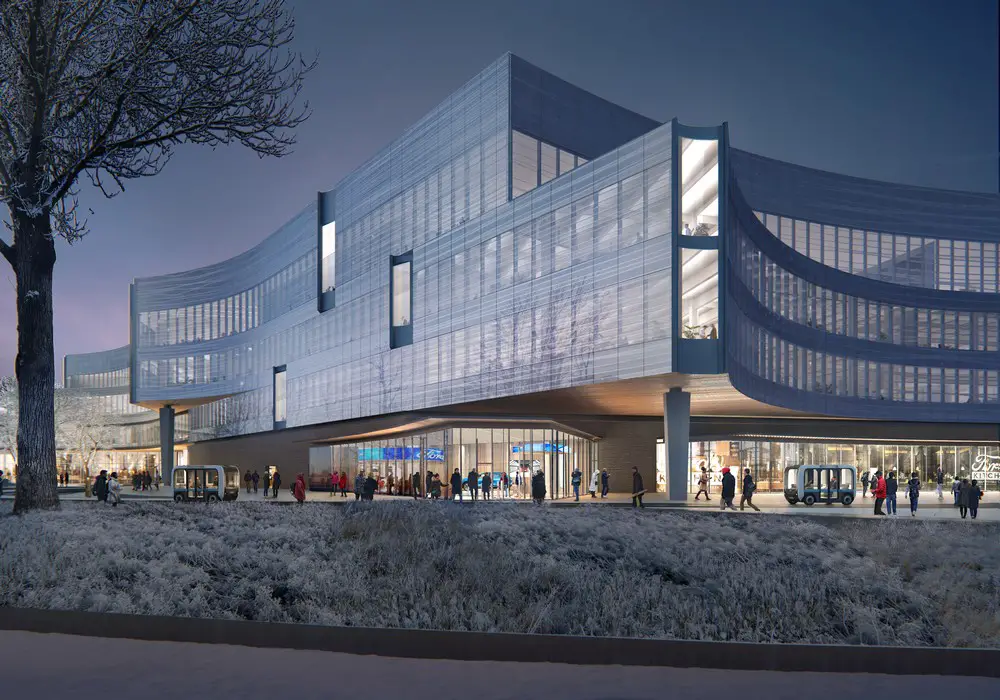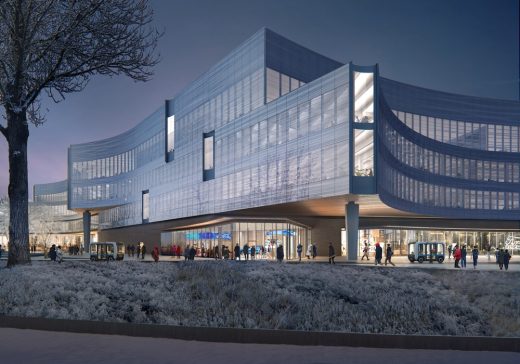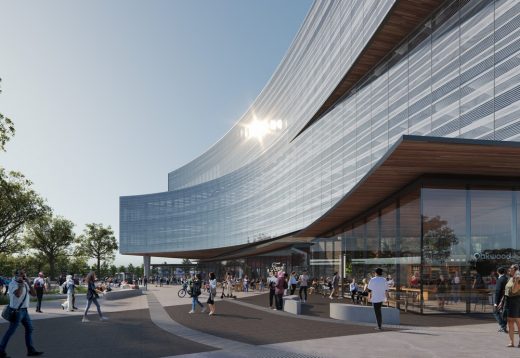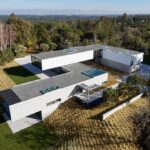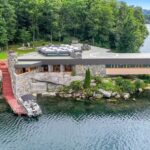New Central Ford Campus Building, MI Research & Engineering Development, American architecture images
New Central Ford Campus Building in Dearborn, Michigan
Apr 23, 2021
New Central Ford Campus Building
Architects: Snøhetta with IBI Group
Location: Dearborn, Michigan, USA
Ford Motor Company has unveiled its New Central Campus Building as part of the transformation of its Research & Engineering (R&E) Campus in Dearborn, Michigan. Snøhetta’s design supports Ford’s aspiration to create an environment that allows it to lead the automotive industry into the future of mobility technologies. Supporting Ford’s new hybrid work-from-home model, the Central Campus building will be a resource that gives employees a place to come together and facilitate the easy flow and circulation of ideas.
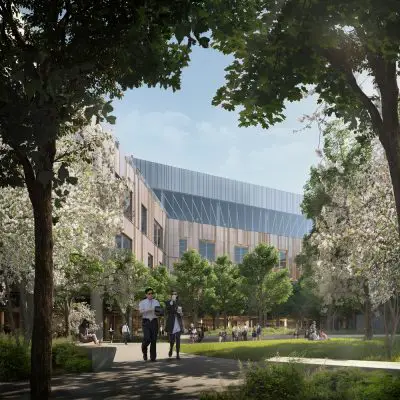
image © Snohetta and Methanoia
The new Central Campus Building is the result of Ford’s 3-year research and planning process, created with Snøhetta as the Design Architect, IBI Group as the Architect of Record, Ghafari as the Engineer of Record, and Arup leading sustainability and engineering. The design emerges from Snøhetta’s Master Plan for the R&E Campus to expand Ford’s core business of automotive manufacturing and lead the industry in future-facing mobility solutions.
It was designed as a new model for an interconnected and resilient workplace of the future. The concept of the building and the surrounding landscape centers on catalyzing opportunities for health, collaboration, co-location and product innovation. Bringing together a technologically advanced workplace with productive landscapes, the new Central Campus Building will open to the public realm and connect to local mobility networks.
Architecture of Innovation
The Central Campus Building will be a new workplace and resource for approximately 6,400 employees from Ford’s many disciplines, including design and engineering. Ford’s talent can come together in a state-of-the-art facility that combines active and social amenity spaces, dynamic and collaborative workplace, as well as innovative and inspiring programs. These functions are carefully dispersed throughout the building and extend to exterior spaces, making work visible and fostering a vibrant and inclusive workplace for future generations of Ford employees.
Designed as a place for people, the project provides accessible gathering areas and employee amenities, ample access to daylight, and views outside the building and across the campus. Simultaneously, the Central Campus Building will function as a healthy workplace that brings people together, optimizing team adjacencies, balancing individual and collaborative workspaces, centralizing equipment and services, integrating advanced technology, and streamlining the movement of people and products. Finally, it serves as a community asset, placed near Oakwood Boulevard and activated with public amenities to engage the community. The architecture supports the vision outlined in the Master Plan and advances the Ford workplace into the future.
The Central Campus Building will include amenities, offices, design studios, fabrication shops, laboratories and courtyards as a network to create proximity between people and product, allowing teams and individual employees to seamlessly interact. The concept design of the building centers on functional spaces like the design studios. These become the building blocks in terms of size and performance needs. The building secures and centralizes product movement while distributing intuitive and effective horizontal and vertical paths of travel.
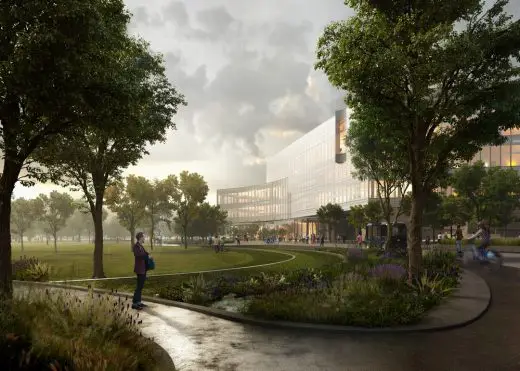
image © Snohetta and Methanoia
Site & Ecology
As the Research & Engineering Campus transitions from a closed to an open campus, the Central Campus Building will create a new public face for Ford opposite notable landmarks such as the Henry Ford Museum and Greenfield Village. The dynamic experience of indoor-outdoor space is a defining characteristic throughout the future campus.
From plazas and courtyards to paths and gardens, the campus landscape is designed to adapt to and celebrate diurnal, seasonal, climatic and social change, immersing users in highly textured, colorful, and fragrant environments that evolve over time. These landscapes, although each aesthetically unique, are each productive—at times an extension of the indoor workplace, a thriving habitat, a horticultural amenity, and a set of programmed places for the Ford community to meaningfully engage with each other and natural systems.
The compact footprint of the Central Campus Building, combined with reduced parking footprints, will dramatically reduce impervious surfaces and provide the opportunity to expand and showcase native planting areas, creative stormwater management, and experiential gardens and plazas as an integral part of the campus experience. Recognizing the link between mental wellbeing and access to the natural world, workplace areas are characterized by strong indoor-outdoor relationships.
Campus Connections: The exterior spaces surrounding the Central Campus Building and adjacent interim and permanent landscapes are designed as distinct spaces that are linked together and highly resilient. Capturing and managing stormwater on-site links planting areas with stormwater channels and site features to create diversity and seasonality across the full campus. Entries are designed with strong physical and visual connections to parking and mobility solutions, and both active and passive landscapes.
Outdoor Workspaces: The designed landscape is composed of outdoor programmed spaces located within courtyards, on roofs, and around the Central Campus Building that facilitate the project goals. These spaces provide employees with connections to the natural world that are both visual and functional.
Courtyards & Terraces: Together, multiple courtyards have been envisioned as a beautiful, engaging, and memorable gallery of Michigan landscape history. Each courtyard is inspired by a different native Michigan landscape, and each will have its own identity, focus and atmosphere. They are conceptualized as lenses into the landscape, both in time and space, and focus on specific plant communities and geologic features. Each will evolve, cast shadows, mark time and infuse workplaces with memory and beauty.
Reimagining the Future Workplace
Aligning with Ford’s people-centric values, the Central Campus Building is designed to catalyze Ford’s vision for the future of their workplace. The building will integrate a highly interconnected network of cross disciplinary teams working together around a product line within physical and visual proximity. Based on a simple plan with interstitial courtyards, the building will create connections across floors, opening to daylight and minimizing travel distances while connecting employees together.
The new workplace will allow for expansion and contraction of shifting teams horizontally or vertically across floors of various widths. From the Central Campus Building’s interiors to its exterior facades and diverse landscapes, the project was designed to express movement. Freedom of innovation and freedom of movement are interrelated concepts, and the design and engineering of the Central Campus Building combines both. Along with the Campus Master Plan, the building embodies the vision for a community-engaged, future-inspired, human-centric workplace. Systems for mobility, site, and architecture work in concert to create a distinct and stimulating campus experience for Ford employees, suppliers, visitors, and the public.
The Central Campus Building communicates both the legacy and the future of Ford. Drawing from a rich legacy of consumer and employee trust, the project was designed as a center of excellence in Ford’s hometown. The Center is a renewed commitment to Ford’s employees, creating a people-first workplace that will also prepare the company to reimagine the future of innovation.
Design: Snøhetta
New Central Ford Campus Building, Dearborn Michigan images / information received 230421
Location: Dearborn, MI, USA
Michigan Architecture
Michigan Architecture Designs
Douglas House
Design: Richard Meier & Partners Architects LLP
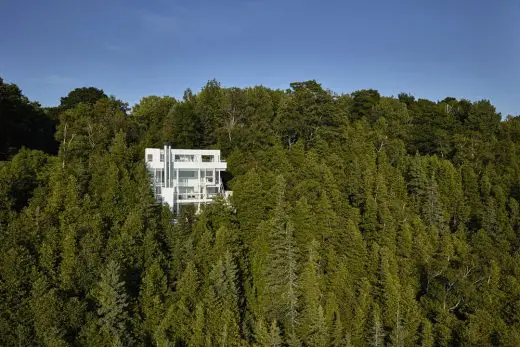
image : James Haefner
Douglas House in Michigan by Richard Meier & Partners Architects on e-architect
Glen Lake Tower
Design: Balance Associates Architects
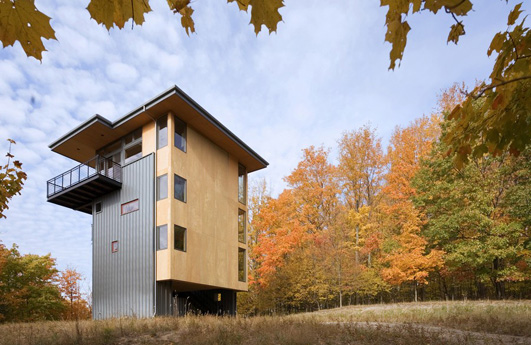
photo : Steve Keating Photography
Glen Lake Tower Michigan
USA Architecture
Comments / photos for the New Central Ford Campus Building, Dearborn Michigan design by Norwegian architects Snøhetta page welcome

